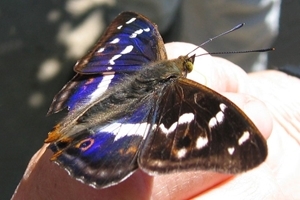Purple emperor butterfly
 Normally when you go looking for butterflies, you might take a net and a guidebook. If you want to find a purple emperor (Apatura iris) – arguably the UK’s most majestic butterfly – you’ll need something that stinks to high heaven and some binoculars, for this is no ordinary butterfly.
Normally when you go looking for butterflies, you might take a net and a guidebook. If you want to find a purple emperor (Apatura iris) – arguably the UK’s most majestic butterfly – you’ll need something that stinks to high heaven and some binoculars, for this is no ordinary butterfly.
Once a widespread inhabitant of British woodlands, the purple emperor is now largely restricted to southern England. With a wingspan of up to 9.2cm, it is our second-largest resident butterfly (the biggest is the swallowtail). A strong flier, it spends much of its time out of our eyeline in the tops of oak trees.
You’ve either got to get a good look at a purple emperor or be very familiar with the nuances of behaviour to distinguish them from another relatively rare high-flier, the white admiral. Underwings of both species are boldly coloured in brown and white, but the emperors have a large orange ‘eye’. Both species and sexes have a dark wing surface with white dots and streaks, but emperors have a small orange circle. The male emperor’s wings have an unmistakable rich iridescent purple sheen when they catch the light.
Like the kingfisher blue, the purple of their wings is a trick of physics rather than a true colour. Purple is a dye relatively rare in nature, hence its association with luxury, royalty and the word ‘emperor’ throughout civilisation. For example, Roman and Byzantine emperors wore cloaks dyed with vivid ‘Tyrian purple’ from slimy mucous of marine snails!
Flashing their purple assets, the male emperors congregate around prominent trees in the peak flight period of July in order to compete for the females. They can be pretty boisterous, and are known to chase off other butterfly species and even birds too. The males’ habit of roosting high in trees makes them susceptible to wind damage, which physically shreds their delicate wings, so the windy nights recently won’t have been good news for this year’s brood.
Once mated, females lay eggs on specially chosen goat or grey willow leaves in stands of sallow scrub. These hatch into well-camouflaged horned green caterpillars, which overwinter in the willows before pupating when summer arrives.
The adult, perhaps like a real emperor, has exotic tastes. Instead of flowers, it prefers to use its long yellow proboscis to drink tree sap and aphid honeydew, also seeking out decaying flesh and faeces to suck up minerals and salt, which is a behaviour more commonly seen in tropical butterfly species.
Purple emperor enthusiasts can have a bit of fun with this, attempting to out-do each other in their quest to discover outrageous-smelling bait in order to tempt them down to the ground to observe and photograph them. I read, with some amusement, accounts of a 7kg dead salmon being hoisted into a tree, and people flocking to known colonies with Stinking Bishop cheese and soiled nappies – I do wonder if the more nauseating foodstuffs are Photoshopped out of the resulting photographs!
The butterfly has a big fan club. In well-known hotspots in July you might see a bunch of excitable people seemingly engaged in a flash mob, but actually a purple emperor has just landed on the sweatiest person mid-step, and the poor chap is precariously teetering whilst everyone else tries to photograph it.
One of the reasons for its historical decline is the reduction in area of sallow thickets in woodlands in close proximity to mature oaks. In the past, foresters rooted out sallow saplings as they were seen as invasive weeds, and woodlands themselves have been fragmented or replanted.
This time last year I was lucky enough to encounter purple emperors within the Farmer Cluster that I facilitate in Dorset, and the record was a first for that farm. It was a wonderful experience watching them fly high in the oaks and then settle on sap runs, near stands of sallow that had been encouraged specifically to try to attract them from a stronghold nearby. What a success for the farmer!
Given its commanding size, regal beauty and filthy habits, I think the purple emperor well and truly befits its name. I hope that the ambitious plans for tree-planting in the future give some consideration to the specific requirements of once-common species such as this, and that we can see a ‘royal flush’ of these lovely insects in future.
N.B. For those who would like to read more about the purple emperor’s colourful natural history, national expert Matthew Oates released a book earlier this year entitled His Imperial Majesty, and Isabella Tree’s Wilding has a great chapter on the arrival and subsequent thriving of the species following natural regeneration at the Knepp Estate in Sussex.
Jess Brooks
Advisory
Photo credit: Kristian Peters